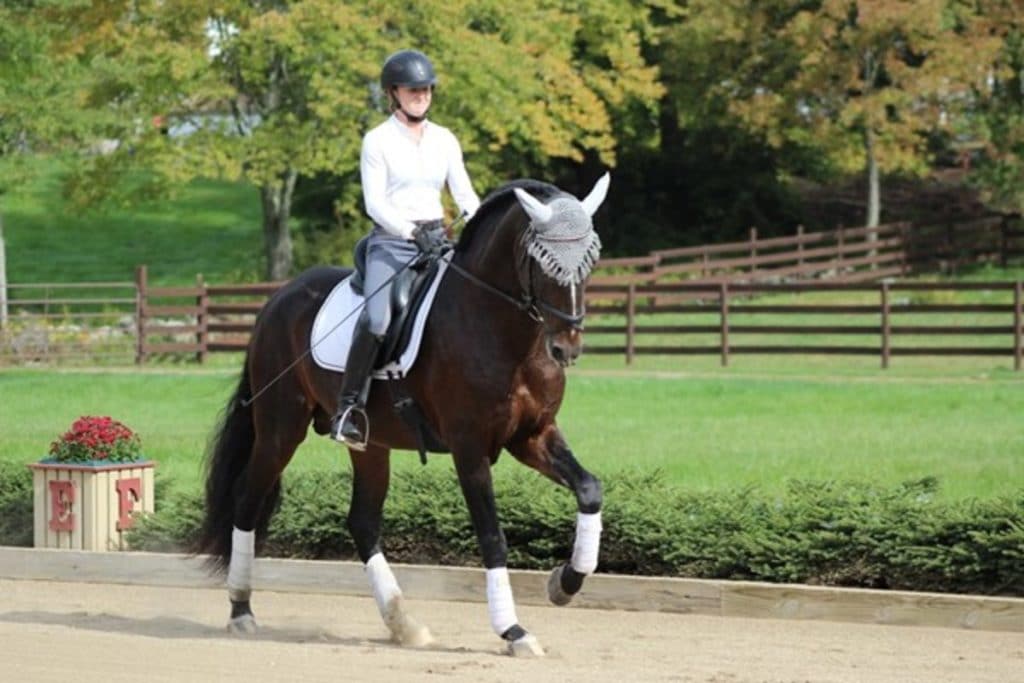To begin with, what is counter canter? In dressage, it is, for example, when you ask your horse to canter on the right lead when the horse is tracking left and vice versa. It’s a very good suppling and strengthening exercise.
First of all, let’s go back to the basics with the canter mechanics. Canter is an asymmetrical three-beat gait. That is to say, there are three successive strikes on the ground, which precede a forward suspension phase, then again three successive strikes.
For example, for a canter on the left lead, the horse goes: (1) right hind, (2) right diagonal pair (left hind and right fore); (3) left fore leg.
In counter-canter, it is thus a question of cantering on the right lead when tracking left or on the left lead when tracking right. When we say tracking right, it means riding on the rail clockwise, and tracking left means riding on the rail anticlockwise. It’s a very common movement that is requested in many dressage tests. It is used a lot to balance the horses and stretch their outer side.
To work on the counter canter, start by warming-up your horse. Remember to keep him very supple. To maintain the counter canter, you will have to keep your horse in a flexion on the side of the lead you’re cantering on. So, in your warm-up, make sure that your horse is ready to change flexion so you can change lead.
Start by changing directions on curved lines that will get progressively deeper, before working on a serpentine and going around corners in counter canter.
My tip: Start with a simple exercise, use a corridor of ground poles to accustom your horse to curved lines. Canter from one corner of the arena to the other in a straight line, and place two poles on the ground, parallel to the rail of the arena on one side. Canter between these two poles and gradually move them away from the rail and closer to the centre of the arena. This way, in order to join the two corners, you’re going to have to ride an increasingly deep curved line.
By practicing the curved line in this way, you learn to control the horse’s balance and impulsion. Being rigorous in the curved line work is what best prepares the counter canter.
Once you’ve mastered the curved line, you can work on a serpentine (with ground poles again). To maintain your counter canter, keep a slight flexion on the side of the lead you are cantering on.
If you are cantering on the right lead, for example, keep a slight neck flexion to the right and also keep your canter aids in place. With your left hand, remember to control the left shoulder. Don’t let your horse bulge on that shoulder. Finally, with your seat, ride your canter slightly diagonally towards the right ear. You will thus accompany the motion of the canter forward and a little to the right.
At the same time, remember to keep your left leg (which is your outside leg) back, simply to stop the hips from shifting to the left. Your leg warns the horse not to move the hips outwards and keeps him balanced.
It is common to see horses with a better quality of true canter than counter canter. The exercise must therefore be repeated so that both become as natural as each other.
Another point that must be emphasised in counter canter is impulsion. Having enough impulsion is paramount. This is because some horses could be tempted to transition to trot or to change lead.
The last point to work on is balance. You must always keep your horse in a good balance to prevent him from leaning on the inside shoulder. Otherwise, he will change lead.
One last tip: Always start working on the easier side. Your horse always has a more supple side that makes the canter easier!
The judges mark the regularity, balance and impulsion of the horse. It is therefore necessary to practise on basic serpentines, curved lines, half circles, then counter canter. It must be well assured, perfect, with a regular rhythm and well balanced.
Do you have difficulties working on your counter canter ? What do you think of this email ? Let me a comment here. See you soon !

